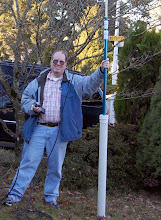Anyway, the Garland, TX folks have a nice two page article on what you need for VHF/UHF connections to Winlink 2000 (http://garlandr.s412.sureserver.com/graces/winlink-fyi.html). Basically, a portable Winlink station requires a computer, a Terminal Node Controller (TNC), a VHF or UHF radio, and an antenna. Simple. I have three of the four pieces, so when money becomes available, I plan to acquire the missing TNC. I'm affiliated with a group that needs reliable communications between several fixed points and sometimes portable sites. Expect traffic during emergencies could be voluminous, which precludes voice for such traffic. Voice works great for short messages, status information, and quick interaction. Logistics traffic during emergencies tends towards big and very detailed. Precision and accuracy matter when you want to order some sleeping cots but get cans of apricots instead. Funny after the fact, maybe, but not useful at the time.
When I visit a web site and find something useful, I try to look around if I have the time. Another document I found really intrigued me. John Galvin Jr., N5TIM, created a document that describes what he calls Communication Resource Functions. He defined ten functions: four voice and six digital communications. His document is at http://garlandr.s412.sureserver.com/graces/resourceTdata.html. The four voice functions are:
- Shadow (VHF/UHF) - follows an official (event, community, church, etc.) and provides communications for that individual. Operates afoot with handheld.
- Base (VHF/UHF) - operates from fixed location with a portable station. Assignments might include event net control or as the communicator at a fixed location such as a shelter or rest stop.
- Mobile (VHF/UHF) - uses a portable station mobile, usually in a vehicle not their own but sometimes in their own vehicle.
- Strategic (HF) - operates portable to stations beyond FM range, possibly using NVIS antennas
The six digital communication functions he defined are:
- APRS (VHF/UHF) - provides event officials or emergency personnel displays of resources in real time. Also provides short messaging ability.
- Digital messaging (VHF/UHF) - provides event/emergency personnel with messaging and radio email capability
- Digital tracker (VHF/UHF) - Sends position of mobile units in real time
- Digital networking (VHF/UHF) - provides 802.11 or similar capability at remote location
- Digital messaging (HF) - long distance messaging capability
- ATV (VHF/UHF) - television from remote site
Each of his descriptions list the items that comprise a fully complemented communication resource that fits the definition. Why do I like this? I've been struggling for the past several years to encourage new hams to equipment themselves so they can serve their community. All of them ask, "What kind of equipment should I buy to do 'X'?"
This resource typing provides a smile means to communicate what a ham needs to operate within a particular assignment area. With a list of items required to serve as a shadow, for example, the ham can acquire a handheld radio, a cigarette lighter adapter, spare battery pack for AA batteries, spare alkaline or rechargeable AA batteries, a speaker mike, and a mobile mag-mount antenna. Add a few office supplies like pen and paper, and the new ham is ready to try an assignment.
I sent a message to N5TIM asking how his work has been accepted, but have not heard back yet. I expect the folks around Dallas have tried the concept, and it looks easy to use. A new person can quickly identify areas where they do not have required equipment, and when able can acquire what they need to meet the standard. I hope to try out the concept locally, and will report back on how it goes.



